Ab Initio Calculations of Transport and Optical Properties of Dense Zr Plasma Near Melting
Abstract
1. Introduction
2. Computational Methods
2.1. Problem Formulation
- the complex dielectric constant aswhere is the vacuum permittivity;
- the complex refractive index as
- the normal spectral reflectivity as
- the absorption coefficient aswhere c is the speed of light in a vacuum;
- the normal spectral emissivity as
2.2. Kubo–Greenwood Formula
2.3. Kramers–Kronig Transform
3. Results and Discussion
4. Conclusions
- We have presented the dynamic electrical conductivity of dense Zr plasma at K and g/cm using the QMD approach and Kubo–Greenwood formula for the first time.
- We have analyzed the influence of simulation parameters of the numerical integration (integration range, integration step) in KKT and the choice of an exchange-correlation functional on the obtained results using normal spectral emissivity as an example.
- We have shown that the inner shell electrons give a limited contribution to the optical properties, so taking into account only the valence electrons provides a good estimate for transport and optical properties.
- We have demonstrated good agreement with the results of our calculations with experiments.
Author Contributions
Funding
Data Availability Statement
Acknowledgments
Conflicts of Interest
References
- Arblaster, J.W. Thermodynamic properties of zirconium. CALPHAD Comput. Coupling Phase Diagrams Thermochem. 2013, 43, 32–39. [Google Scholar] [CrossRef]
- Pigott, J.S.; Velisavljevic, N.; Moss, E.K.; Draganic, N.; Jacobsen, M.K.; Meng, Y.; Hrubiak, R.; Sturtevant, B.T. Experimental melting curve of zirconium metal to 37 GPa. J. Phys. Condens. Matter 2020, 32, 355402. [Google Scholar] [CrossRef] [PubMed]
- Boikov, A.; Payor, V. The Present Issues of Control Automation for Levitation Metal Melting. Symmetry 2022, 14, 1968. [Google Scholar] [CrossRef]
- Smirnova, D.E.; Starikov, S.V.; Gordeev, I.S. Evaluation of the structure and properties for the high-temperature phase of zirconium from the atomistic simulations. Comput. Mater. Sci. 2018, 152, 51–59. [Google Scholar] [CrossRef]
- Apfelbaum, E.M.; Vorob’ev, V.S. Correspondence between the Critical and the Zeno-Line Parameters for Classical and Quantum Liquids. J. Phys. Chem. B 2009, 113, 3521–3526. [Google Scholar] [CrossRef]
- Apfelbaum, E.M.; Vorob’ev, V.S. The Wide-Range Method to Construct the Entire Coexistence Liquid–Gas Curve and to Determine the Critical Parameters of Metals. J. Phys. Chem. B 2015, 119, 11825–11832. [Google Scholar] [CrossRef]
- Jakse, N.; Pasturel, A. Local Order of Liquid and Supercooled Zirconium by Ab Initio Molecular Dynamics. Phys. Rev. Lett. 2003, 91, 195501. [Google Scholar] [CrossRef]
- Jakse, N.; Bacq, O.L.; Pasturel, A. Short-range order of liquid and undercooled metals: Ab initio molecular dynamics study. J. Non-Cryst. Solids 2007, 353, 3684–3688. [Google Scholar] [CrossRef]
- Desai, P.D.; James, H.M.; Ho, C.Y. Electrical Resistivity of Vanadium and Zirconium. J. Phys. Chem. Ref. Data 1984, 13, 1097–1130. [Google Scholar] [CrossRef]
- Korobenko, V.N.; Savvatimskii, A.I. Temperature Dependence of the Density and Electrical Resistivity of Liquid Zirconium up to 4100 K. High Temp. 2001, 39, 525–531. [Google Scholar] [CrossRef]
- Korobenko, V.; Savvatimski, A.; Sevostyanov, K. Experimental investigation of solid and liquid zirconium. High Temp. High Press. 2001, 33, 647–658. [Google Scholar] [CrossRef]
- Korobenko, V.N.; Agranat, M.B.; Ashitkov, S.I.; Savvatimskiy, A.I. Zirconium and iron densities in a wide range of liquid states. Int. J. Thermophys. 2002, 23, 307–318. [Google Scholar] [CrossRef]
- Cezairliyan, A.; Righini, F. Measurement of melting point, radiance temperature (at melting point), and electrical resistivity (above 2,100 K of zirconium by a pulse heating method. Rev. Int. Hautes Temp. Refract. 1975, 12, 201–207. [Google Scholar]
- Cagran, C.; Brunner, C.; Seifter, A.; Pottlacher, G. Liquid-phase behaviour of normal spectral emissivity at 684.5 nm of some selected metals. High Temp. High Press. 2002, 34, 669–679. [Google Scholar] [CrossRef]
- Brunner, C.; Cagran, C.; Seifter, A.; Pottlacher, G. The Normal Spectral Emissivity at a Wavelength of 684.5 nm and Thermophysical Properties of Liquid Zirconium Up to the End of the Stable Liquid Phase. AIP Conf. Proc. 2003, 684, 771–776. [Google Scholar] [CrossRef]
- Krishnan, S.; Anderson, C.D.; Nordine, P.C. Optical properties of liquid and solid zirconium. Phys. Rev. B 1994, 49, 3161–3166. [Google Scholar] [CrossRef]
- Ronchi, C.; Hiernaut, J.P.; Hyland, G.J. Emissivity X Points in Solid and Liquid Refractory Transition Metals. Metrologia 1992, 29, 261–271. [Google Scholar] [CrossRef]
- Peletskii, V.E.; Druzhinin, V.; Sobol’, Y.G. Emissivity, thermal conductivity, and electrical conductivity of remelted zirconium at high temperatures. Teplofiz. Vys. Temp. 1970, 8, 774–779. [Google Scholar]
- Baria, D.N.; Bautista, R.G. Effect of surface conditions on the normal spectral emittance of titanium and zirconium between 1000 and 1800 K. Metall. Trans. 1974, 5, 555–560. [Google Scholar] [CrossRef]
- Cezairliyan, A.; Righini, F. Simultaneous measurements of heat capacity, electrical resistivity and hemispherical total emittance by a pulse heating technique: Zirconium, 1500 to 2100 K. J. Res. Natl. Bur. Stand. Sect. A 1974, 78A, 509. [Google Scholar] [CrossRef]
- Petrova, I.I.; Peletskii, V.E.; Samsonov, B.N. Investigation of the thermophysical properties of zirconium by subsecond pulsed heating technique. High Temp. 2000, 38, 560–565. [Google Scholar] [CrossRef]
- Milošević, N.D.; Maglić, K.D. Thermophysical Properties of Solid Phase Zirconium at High Temperatures. Int. J. Thermophys. 2006, 27, 1140–1159. [Google Scholar] [CrossRef]
- Kuzenov, V.V.; Ryzhkov, S.V. The Qualitative and Quantitative Study of Radiation Sources with a Model Configuration of the Electrode System. Symmetry 2021, 13, 927. [Google Scholar] [CrossRef]
- Desjarlais, M.P.; Kress, J.D.; Collins, L.A. Electrical conductivity for warm, dense aluminum plasmas and liquids. Phys. Rev. E 2002, 66, 025401. [Google Scholar] [CrossRef] [PubMed]
- Clérouin, J.; Laudernet, Y.; Recoules, V.; Mazevet, S. Ab initiostudy of the optical properties of shocked LiF. Phys. Rev. B 2005, 72, 155122. [Google Scholar] [CrossRef]
- Knyazev, D.V.; Levashov, P.R. Ab initio calculation of transport and optical properties of aluminum: Influence of simulation parameters. Comput. Mater. Sci. 2013, 79, 817–829. [Google Scholar] [CrossRef]
- Hu, S.X.; Collins, L.A.; Goncharov, V.N.; Boehly, T.R.; Epstein, R.; McCrory, R.L.; Skupsky, S. First-principles opacity table of warm dense deuterium for inertial-confinement-fusion applications. Phys. Rev. E 2014, 90, 033111. [Google Scholar] [CrossRef]
- Knyazev, D.V.; Levashov, P.R. Transport and optical properties of warm dense aluminum in the two-temperature regime: Ab initio calculation and semiempirical approximation. Phys. Plasmas 2014, 21, 073302. [Google Scholar] [CrossRef]
- Karasiev, V.V.; Calderín, L.; Trickey, S.B. Importance of finite-temperature exchange correlation for warm dense matter calculations. Phys. Rev. E 2016, 93, 063207. [Google Scholar] [CrossRef]
- Knyazev, D.V.; Levashov, P.R. Thermodynamic, transport, and optical properties of dense silver plasma calculated using the GreeKuP code. Contrib. Plasma Phys. 2018, 59, 345–353. [Google Scholar] [CrossRef]
- Norman, G.; Saitov, I.; Stegailov, V.; Zhilyaev, P. Ab initiocalculation of shocked xenon reflectivity. Phys. Rev. E 2015, 91, 023105. [Google Scholar] [CrossRef]
- Norman, G.; Saitov, I. Brewster angle and reflectivity of optically nonuniform dense plasmas. Phys. Rev. E 2016, 94, 043202. [Google Scholar] [CrossRef]
- Dai, J.; Gao, C.; Sun, H.; Kang, D. Electronic and optical properties of warm dense lithium: Strong coupling effects. J. Phys. B At. Mol. Opt. Phys. 2017, 50, 184004. [Google Scholar] [CrossRef]
- Calderin, L.; Karasiev, V.V.; Trickey, S.B. Kubo–Greenwood electrical conductivity formulation and implementation for projector augmented wave datasets. Comput. Phys. Commun. 2017, 221, 118–142. [Google Scholar] [CrossRef]
- Zhang, H.; Zhang, S.; Kang, D.; Dai, J.; Bonitz, M. Finite-temperature density-functional-theory investigation on the nonequilibrium transient warm-dense-matter state created by laser excitation. Phys. Rev. E 2021, 103, 013210. [Google Scholar] [CrossRef]
- Kaplan, I.G. Modern state of the Pauli exclusion principle and the problems of its theoretical foundation. Symmetry 2020, 13, 21. [Google Scholar] [CrossRef]
- Martin, R.M. Electronic Structure: Basic Theory and Practical Methods; Cambridge University Press: Cambridge, UK, 2020. [Google Scholar]
- Kresse, G.; Furthmüller, J. Efficient iterative schemes forab initiototal-energy calculations using a plane-wave basis set. Phys. Rev. B 1996, 54, 11169–11186. [Google Scholar] [CrossRef]
- Kresse, G.; Joubert, D. From ultrasoft pseudopotentials to the projector augmented-wave method. Phys. Rev. B 1999, 59, 1758–1775. [Google Scholar] [CrossRef]
- Kowalski, P.M.; Mazevet, S.; Saumon, D.; Challacombe, M. Equation of state and optical properties of warm dense helium. Phys. Rev. B 2007, 76, 075112. [Google Scholar] [CrossRef]
- Toll, J.S. Causality and the Dispersion Relation: Logical Foundations. Phys. Rev. 1956, 104, 1760–1770. [Google Scholar] [CrossRef]
- GitHub. Available online: https://github.com/vf8/KrKrTr (accessed on 1 March 2022).
- Perdew, J.P.; Burke, K.; Ernzerhof, M. Generalized Gradient Approximation Made Simple. Phys. Rev. Lett. 1996, 77, 3865–3868, Erratum in Phys. Rev. Lett. 1997, 78, 1396. [Google Scholar] [CrossRef] [PubMed]
- Paramonov, M.A.; Minakov, D.V.; Fokin, V.B.; Knyazev, D.V.; Demyanov, G.S.; Levashov, P.R. Ab initio inspection of thermophysical experiments for zirconium near melting. J. Appl. Phys. 2022, 132, 065102. [Google Scholar] [CrossRef]
- Ceperley, D.M.; Alder, B.J. Ground State of the Electron Gas by a Stochastic Method. Phys. Rev. Lett. 1980, 45, 566–569. [Google Scholar] [CrossRef]
- Armiento, R.; Mattsson, A.E. Functional designed to include surface effects in self-consistent density functional theory. Phys. Rev. B 2005, 72, 085108. [Google Scholar] [CrossRef]
- Cezairliyan, A.; McClure, J.; Miiller, A. Radiance temperatures (in the wavelength range 523–907 nm) of group IVB transition metals titanium, zirconium, and hafnium at their melting points by a pulse-heating technique. Int. J. Thermophys. 1994, 15, 993–1009. [Google Scholar] [CrossRef]
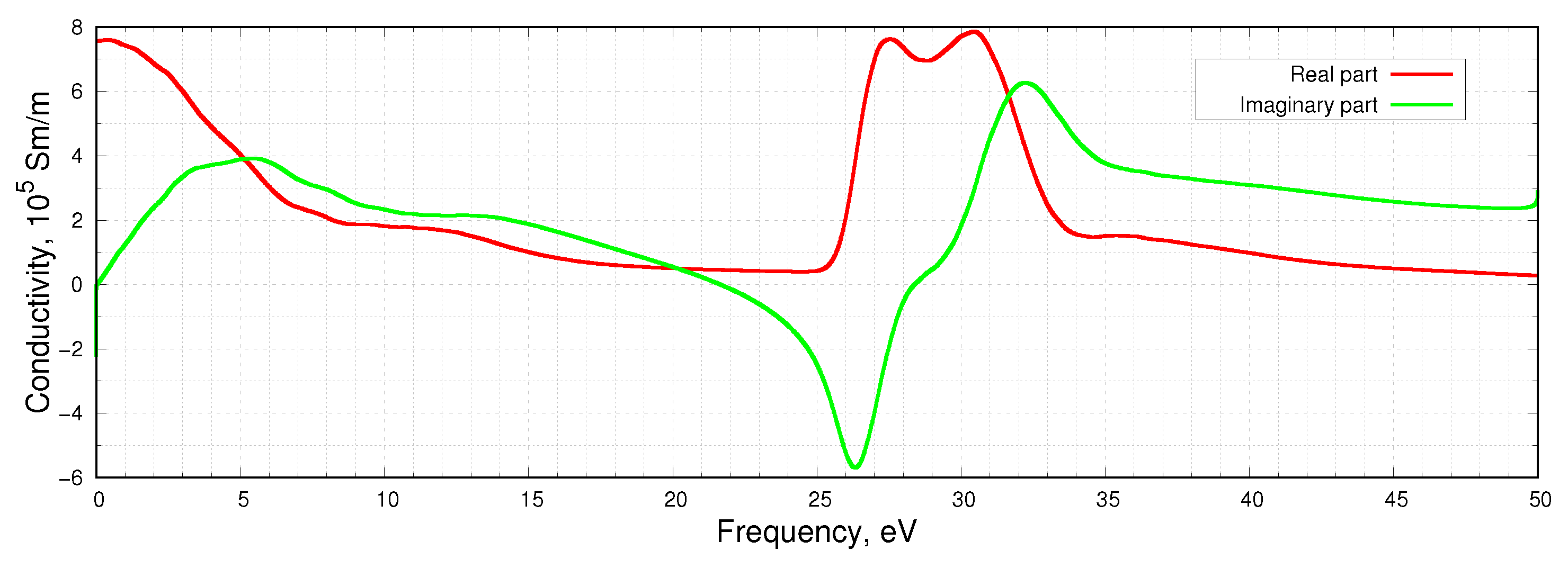
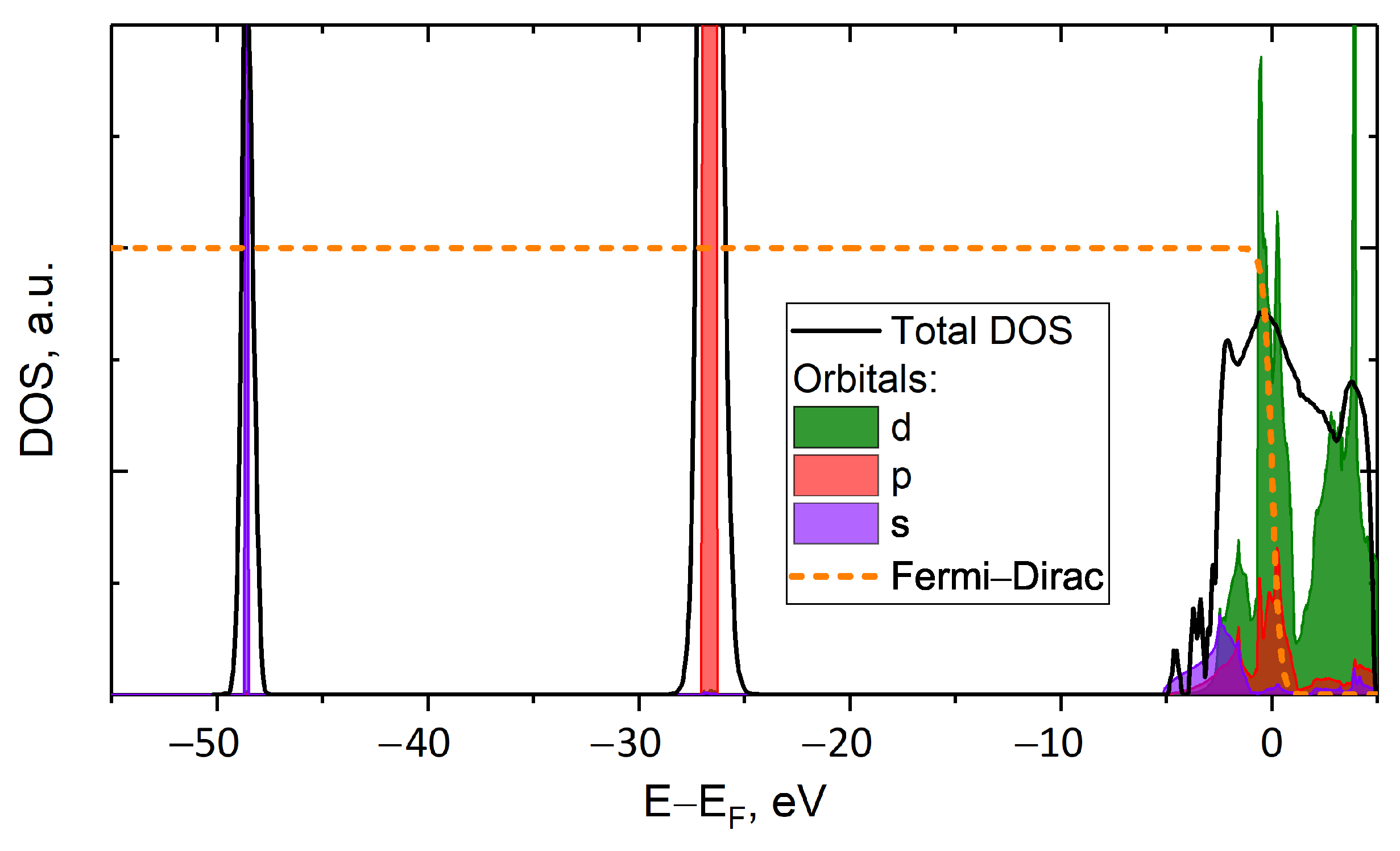
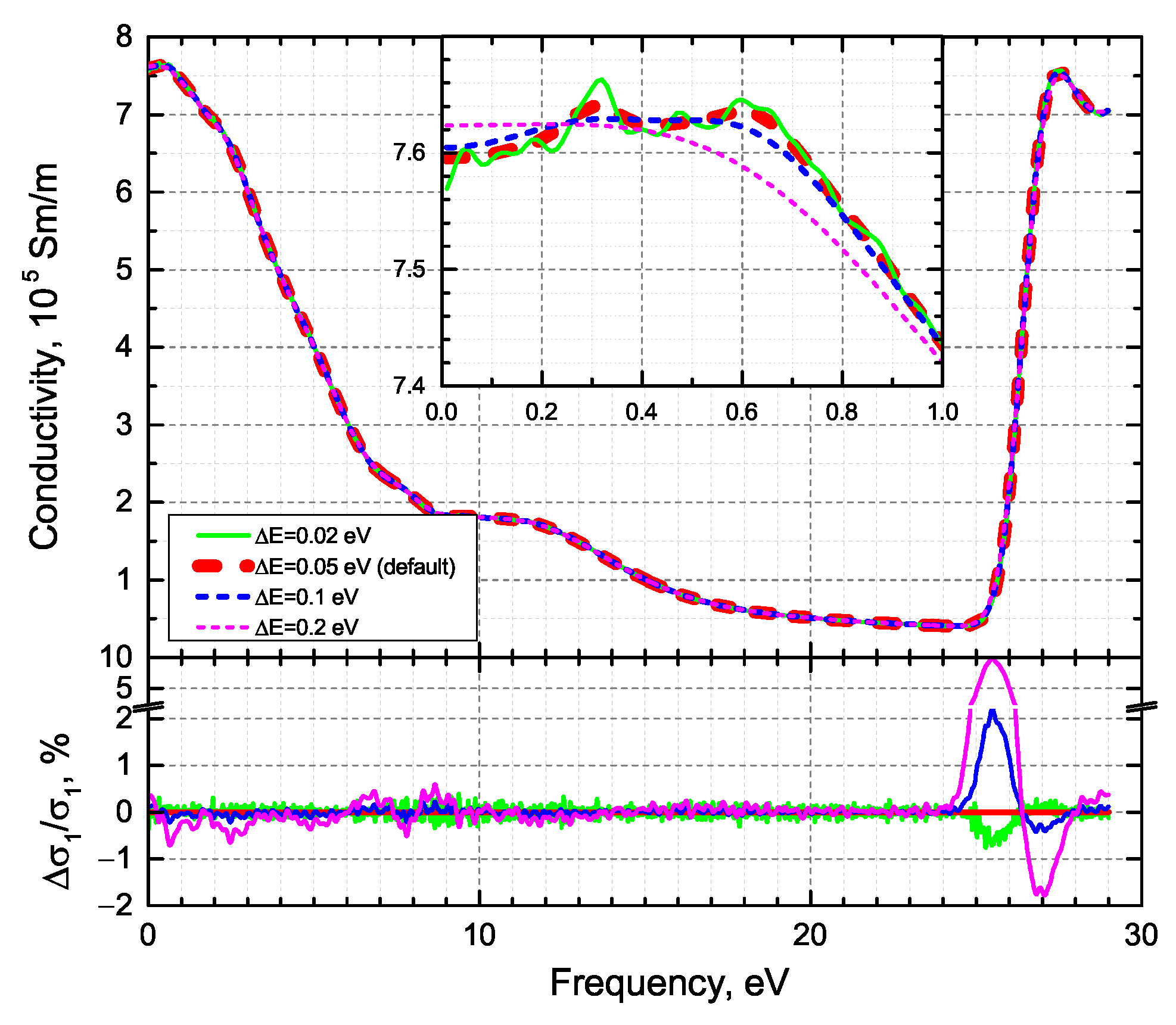
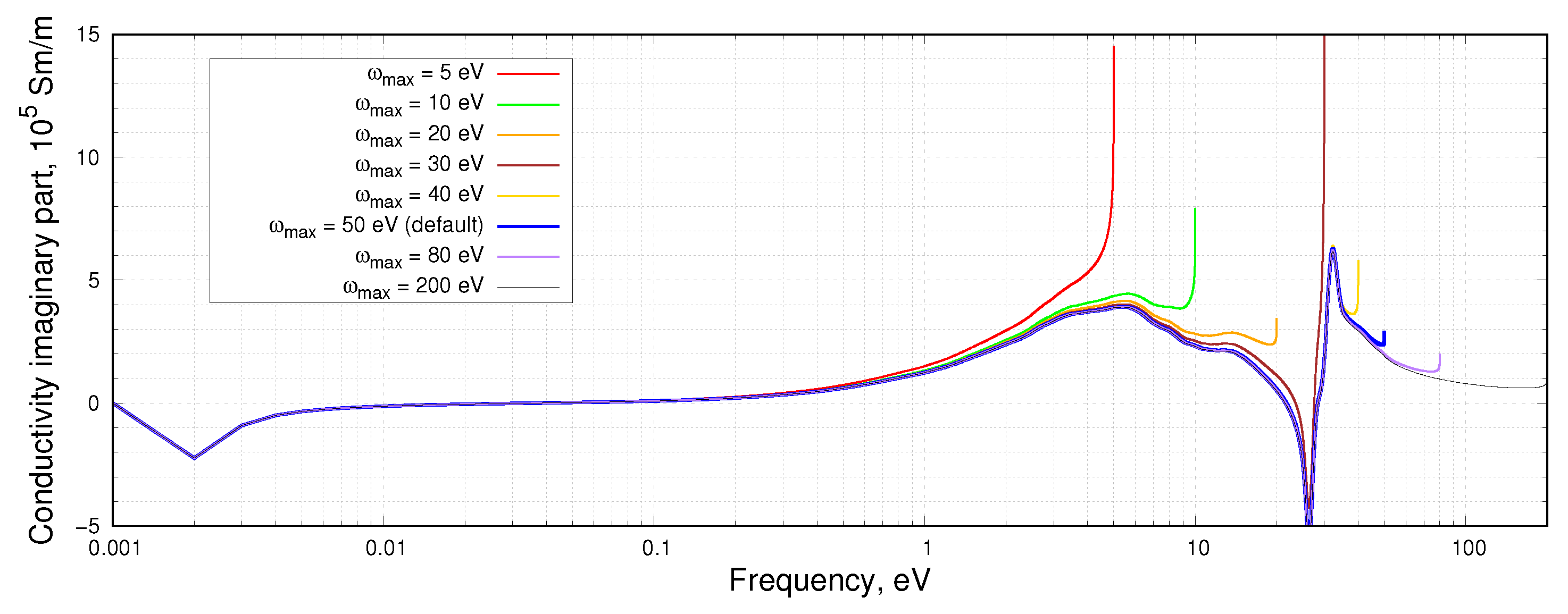
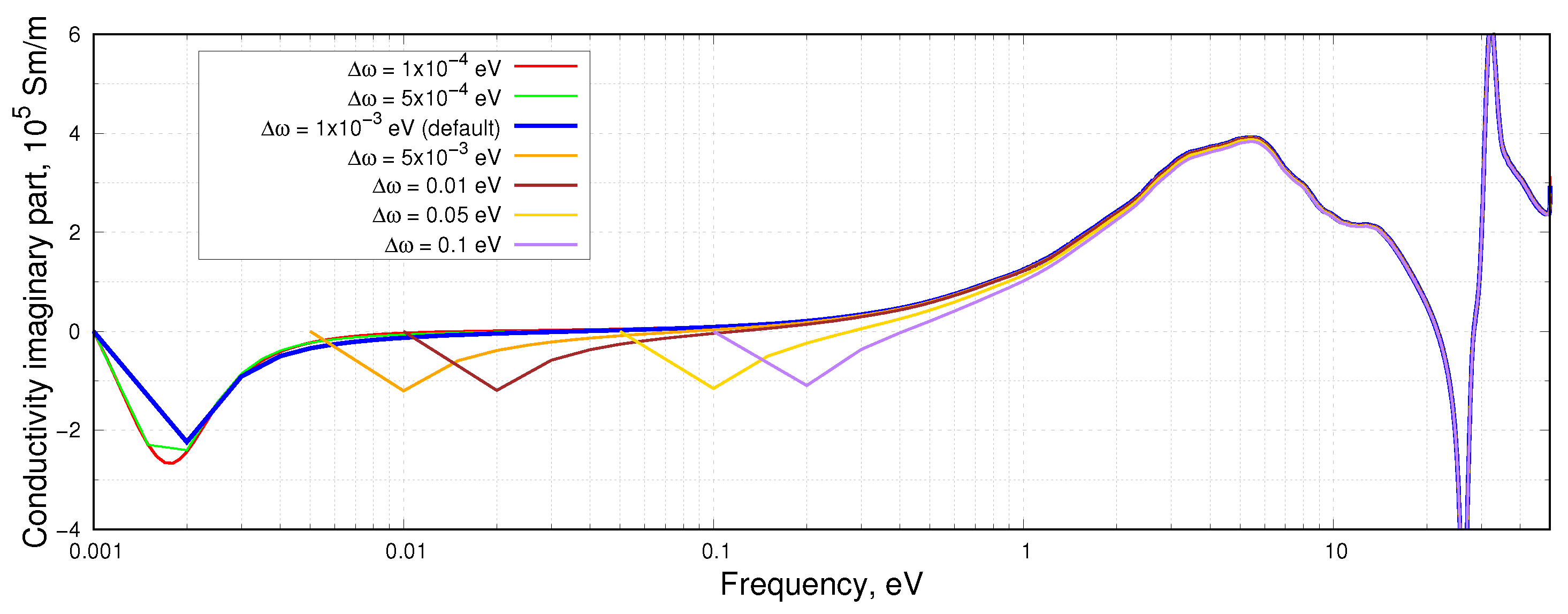


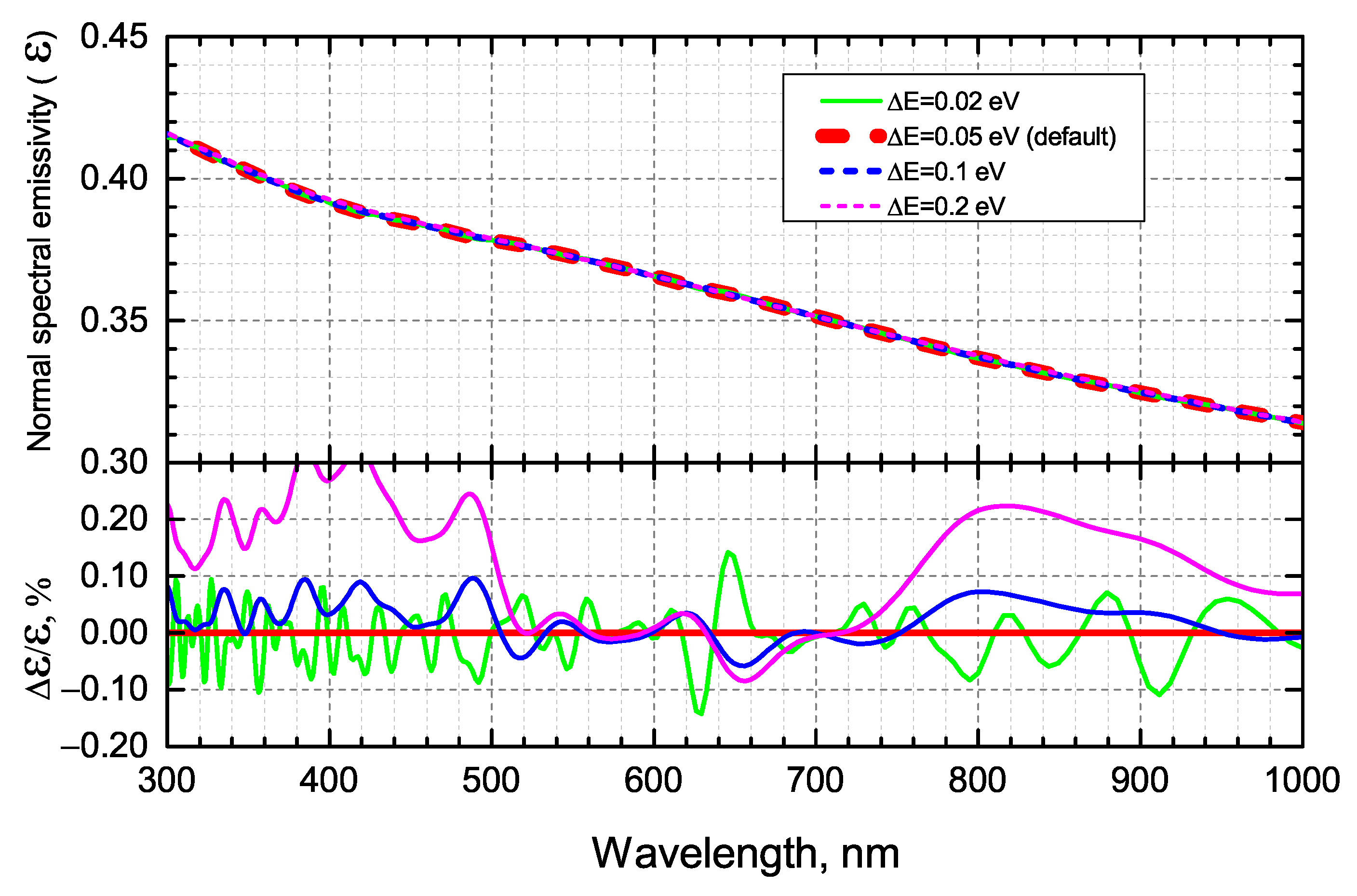
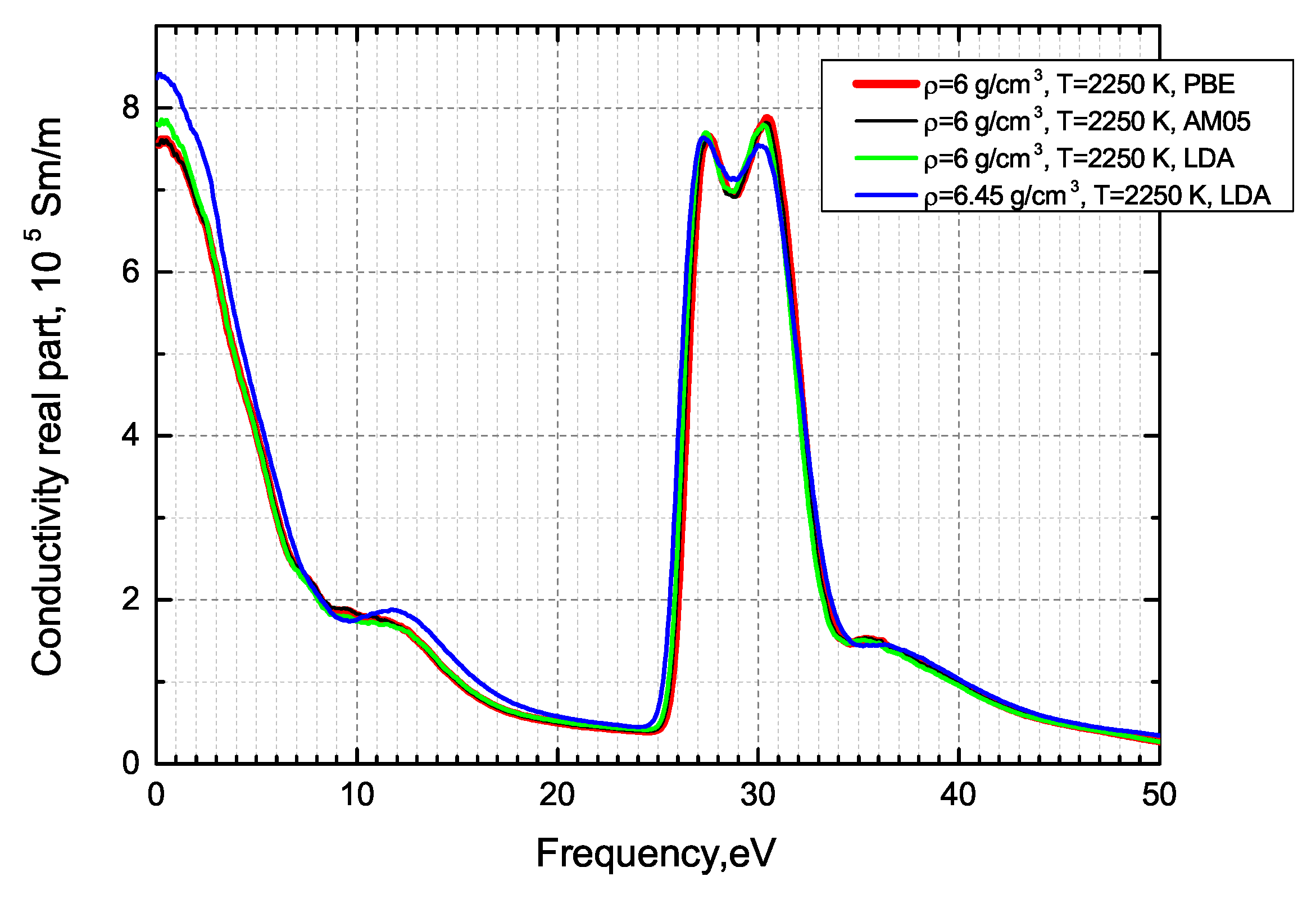
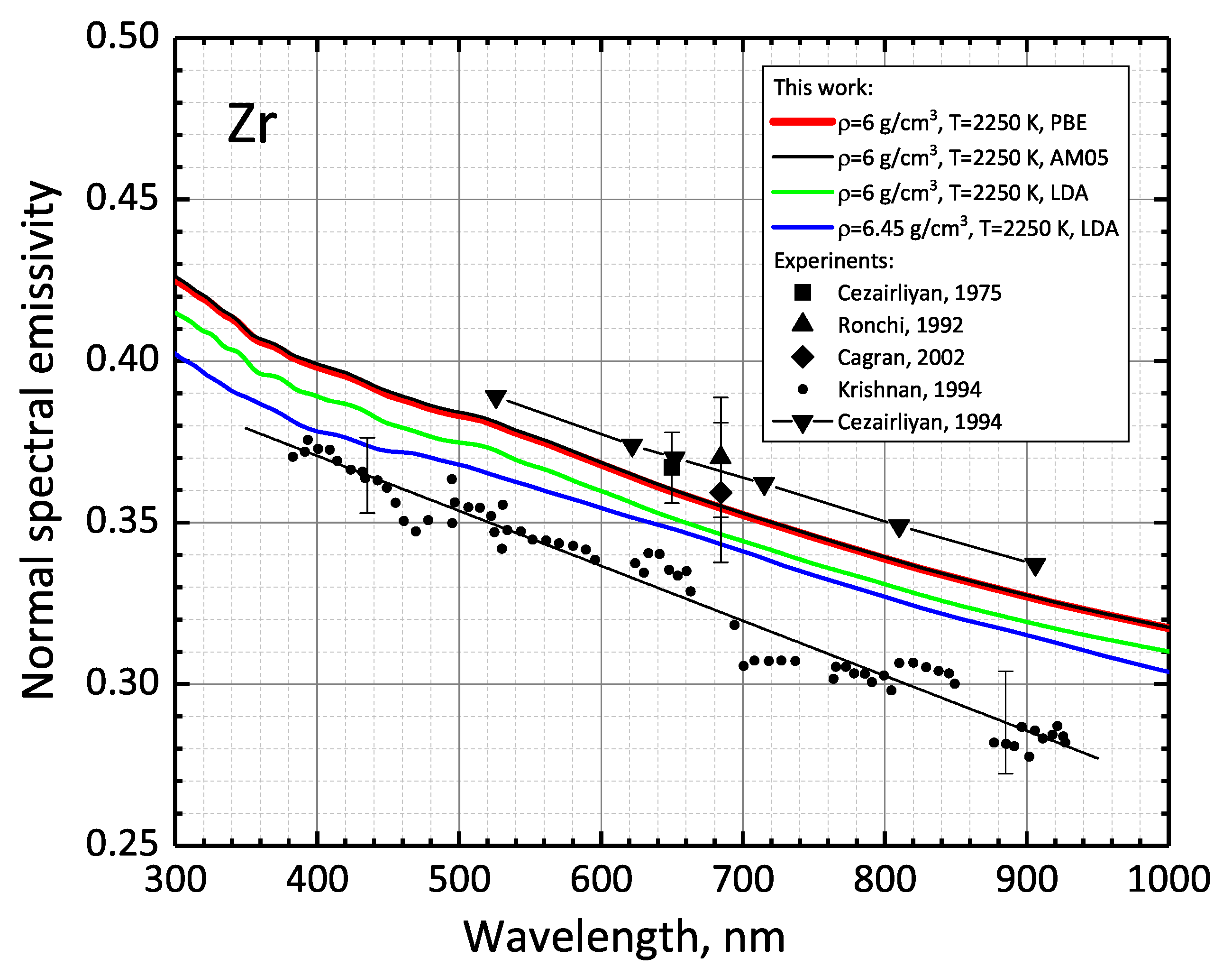
Disclaimer/Publisher’s Note: The statements, opinions and data contained in all publications are solely those of the individual author(s) and contributor(s) and not of MDPI and/or the editor(s). MDPI and/or the editor(s) disclaim responsibility for any injury to people or property resulting from any ideas, methods, instructions or products referred to in the content. |
© 2022 by the authors. Licensee MDPI, Basel, Switzerland. This article is an open access article distributed under the terms and conditions of the Creative Commons Attribution (CC BY) license (https://creativecommons.org/licenses/by/4.0/).
Share and Cite
Fokin, V.; Minakov, D.; Levashov, P. Ab Initio Calculations of Transport and Optical Properties of Dense Zr Plasma Near Melting. Symmetry 2023, 15, 48. https://doi.org/10.3390/sym15010048
Fokin V, Minakov D, Levashov P. Ab Initio Calculations of Transport and Optical Properties of Dense Zr Plasma Near Melting. Symmetry. 2023; 15(1):48. https://doi.org/10.3390/sym15010048
Chicago/Turabian StyleFokin, Vladimir, Dmitry Minakov, and Pavel Levashov. 2023. "Ab Initio Calculations of Transport and Optical Properties of Dense Zr Plasma Near Melting" Symmetry 15, no. 1: 48. https://doi.org/10.3390/sym15010048
APA StyleFokin, V., Minakov, D., & Levashov, P. (2023). Ab Initio Calculations of Transport and Optical Properties of Dense Zr Plasma Near Melting. Symmetry, 15(1), 48. https://doi.org/10.3390/sym15010048





